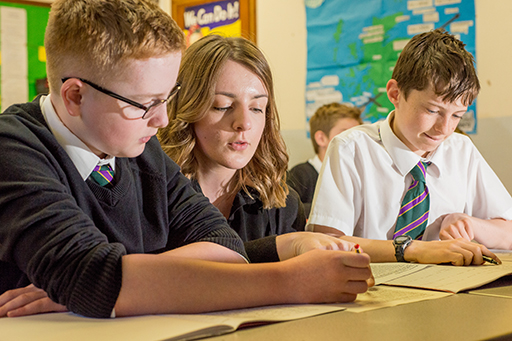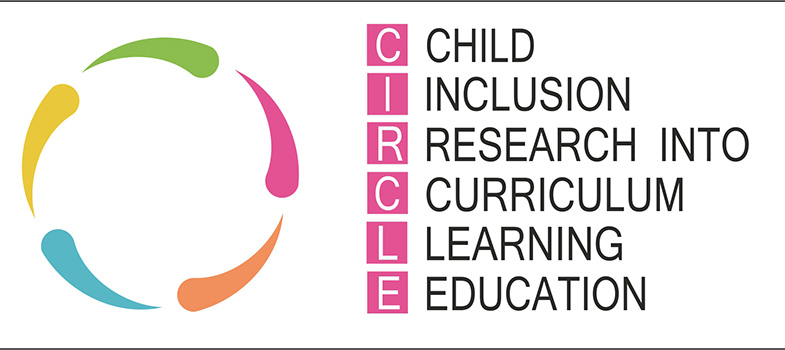1.3 Inclusion in Practice: The CIRCLE Framework

Show description|Hide descriptionCIRCLE Logo which has the acronym for the word CIRCLE within the design.
Child
Inclusion
Research Into
Curriculum
Learning
Education
CIRCLE begins from the stand point that teachers are experts in teaching and that what is required to support inclusion is a framework that allows this expertise to be applied in the most effective way, using a set of general principles.

Figure 5 Supporting learners
Show description|Hide descriptionThe photograph shows a teacher supporting a male learner discussing his work at his class desk
Within the CIRCLE Framework, inclusion is referred to as the extent to which a learner participates in school life, is accepted by their peers and progresses with their learning.
There can be a tendency to focus on how specific physical, sensory or behavioural strengths and support needs can impact on a learner’s ability to be included in school; however, this is usually only a small part of the picture. We know from current research, for example Maciver et al. (2018), that inclusion is influenced by a combination of factors including the physical environment, attitudes, expectations and opportunities, in addition to the learner’s skills and abilities.
Many resources focus on skill development. The CIRCLE Framework, however, introduces the importance of considering inclusion in terms of four factors:
The environment (physical and social)
Structures and routines
Motivation
Skills.
The terminology for these four factors comes from the Model of Human Occupation (MOHO), Kielhofner (2008). Further reading is available in the Useful information section.
The interactive jigsaw diagram in Figure 6 below represents how these factors are interlinked to support inclusion. Hover over each segment of the jigsaw - number 1 displays a definition and number 2 displays an example. Each of the factors within the CIRCLE Framework are described fully in Section 3 with examples to illustrate the concepts.
Active content not displayed. This content requires JavaScript to be enabled.
Figure 6. CIRCLE Inclusion Factors
Show description|Hide descriptionThe jigsaw diagram represents how four factors are interlinked to support inclusion. The four pieces of the jigsaw say skills, motivation, the environment, and finally structures and routines. On each part of the jigsaw there are the numbers one and two. Number one opens a description and number two opens an example. For skills the description is skills refer to a learner’s ability in the following areas: attention and concentration; organisation and planning; motor skills; socialising, emotions and relationships; verbal and non-verbal communication. The example for skills is Kit loves physical education. However, she is uncoordinated in all her movements and is very poor at throwing and catching a ball. She will need activities and support at the appropriate level to help her succeed and to help her learn and develop new movement skills. For the next part of the jigsaw, motivation, the description is motivation gives learners incentive, enthusiasm and interest when engaging with activities and the people around them. Learners can be motivated by their own feelings, desires, self-esteem, confidence and the responses of others. The example for motivation is Surdeep is prevented from learning by his fear of failure. He thinks he will not be good at anything he tries so avoids new activities. He needs support and some individual encouragement to be motivated to engage in new activities to develop his skills and to experience the feeling of success. The next piece in the jigsaw is the environment. The description says that the environment includes both the physical and social factors. The physical environment refers to the physical layout of the classroom and the resources used within it. The social environment concerns the attitudes, expectations and actions of peers and adults. The example for the environment is Iggy is very easily distracted which prevents him engaging fully in an activity. He needs careful management of his environment, including seating him away from windows, doors and other distractions and provision of a personalised task list which he ticks off as he completes, to support his learning. The last piece if the jigsaw is structures and routines. The description is structures and routines are events that happen in the same way with regularity. The start, middle and end of the routine becomes predictable through repetition. Daily routines help learners to know and anticipate what comes next and social routines help them enjoy and interact with others. The example given for structures and routines is Anna always forgets what she has to bring to school each day, which means she misses out on learning opportunities. By ensuring that specific activities such as homework are done consistently on the same day each week, she can (with the help of her parents) ensure she is organised.
Interactive feature not available in single page view (
see it in standard view).


